
Emerging markets like telehealth and managed care organizations are increasing the competition when it comes to physician recruitment, forcing healthcare organizations to adapt to provide the employment experience physicians want. Here’s how the physician recruitment landscape is changing and what you can do to recruit and retain the physicians your organization needs.
Novel challenges to physician recruitment
The greatest challenge to recruiting quality doctors is the physician shortage, “which is only continuing to get worse as time goes on,” said Austin Chatlin, managing director of CHG Healthcare’s advisory services. The Association of American Medical Colleges (AAMC) projects a physician shortage of up to 86,000 physicians by 2036.

Additionally, physicians are skewing older. According to the AAMC, it’s likely that more than a third of currently active physicians will retire by 2034. As this wave of physicians begins to leave the field, physician hiring will only become more competitive. That’s why physician retirement should factor into organizational projections and plans for future physician recruitment.
Emergence of increased competition for physicians’ time
Another headwind facing healthcare organizations is the proliferation of competitors hiring physicians. “There are actually 1,300 of these [emerging market] organizations vying for your physicians—not only for physicians who you are trying to attract, but also physicians you currently employ today,” says Chatlin.
“If you’re going to be recruiting physicians over the next five years, it’s going to be two to three times harder to recruit and retain a physician than it has been,” Chatlin adds.
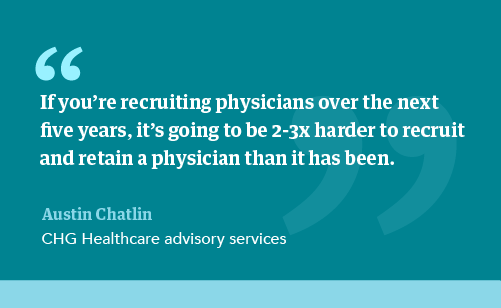
Younger physicians don’t want their own practice
It’s not all bad news. Although the market is tight, more physicians are open to working in an employed capacity, rather than owning their own practice. “If you look back 20 to 30 years, most physicians owned their own practice,” Chatlin said. “Over the past dozen years, that number has decreased significantly.”
The American Medical Association (AMA) reported that 42% of physicians owned their practice in 2024, compared with 60% in 2012. That downward trend looks like it will continue: A 2023 CHG Healthcare study of residents and fellows found that 70% of them plan to take an employed position after their training is complete.
4 winning strategies to help you attract physicians
With a larger share of physicians than ever before becoming interested in employment, healthcare organizations have an opportunity to compete, but only if they’re willing to provide what today’s physicians want. Here are four strategies that can help hospitals become more attractive to physicians.

1. Offer greater flexibility
Work-life balance was a nearly universal desire by physicians, with 86% reporting it’s an important aspect of their work, according to CHG Healthcare’s 2025 Physician Sentiment Survey.
Physicians want flexibility, and they’re finding it with telehealth and other emerging competitors. “That means flexibility with where they work and how they work,” Chatlin said.
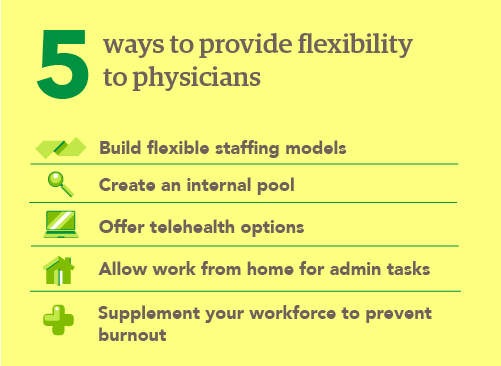
Some ways to offer that flexibility include:
- Building flexible staffing models
- Creating an internal pool
- Offering telehealth options
- Allowing work from home for admin tasks
- Supplementing your workforce as needed to prevent burnout
Increase efficiency: 5 strategies for optimizing your healthcare workforce
2. Focus on engagement
“Flexibility is tied directly to engagement, and engagement is tied directly to turnover and retention rates,” Chatlin explained. “What we mean by engagement is giving physicians the ability to have a say in the direction of the organization. We need to listen to what they have to say, and then deliver action items to demonstrate what we’re doing about it.”
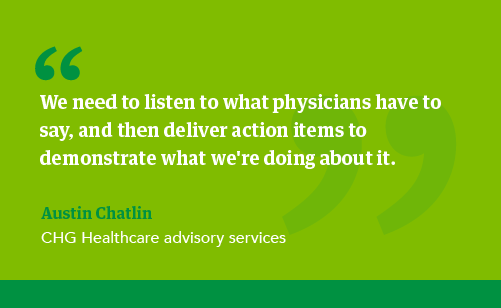
Only one-third of physicians (33%) believe executive leaders have their best interests in mind when implementing policies, and fewer than half (42%) feel that leaders care about physician wellness, according to the CHG physician sentiment survey. This lack of confidence affects engagement and increases the risk of turnover.
Even so, Chatlin says only a quarter of organizations have developed an engagement strategy or devoted resources to it.
An effective engagement strategy must be formalized and include physician surveys, monitoring results over time, and communicating any actions taken. While many organizations undertake engagement efforts, the most effective outcomes occur when initiatives come from a centralized point.
Bottom line: Physicians need to know that if they’ve taken the time to provide feedback, the organization has actually listened.
Retain your top talent: 8 solutions that reduce turnover and improve retention
3. Increase the recruitment budget
More than ever, competition for hiring physicians is fierce. Recruitment budgets need to reflect that reality. “We’re recommending that recruitment budgets go up 20% to 30% over the next five years, depending on where you’re currently at,” said Chatlin. “And you need to ensure that most of that goes to direct recruitment and onboarding efforts.”

Chatlin said healthcare organizations should follow a 1:3:1 ratio, where organizations have one sourcer and one onboarder for every three recruiters. “Most organizations don’t have that ratio. But to successfully navigate this new market, you absolutely need to have this structure in place.”
Do more with less: How to use AI to enhance the physician recruiting process
4. Integrate recruitment with other physician support services
Physician recruitment should never happen in a silo. Instead, recruitment should be part of a larger coalition of divisions that fall under the umbrella of physician services. Healthcare organizations need to “quickly evolve to create a more centralized vertical dedicated to physician services and physician operations at large,” Chatlin said.
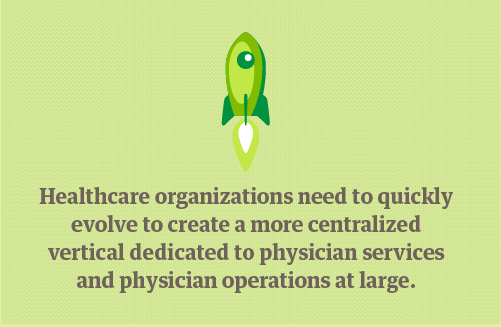
Focus areas that belong in this vertical include compensation, engagement, retention, physician wellness, and even efforts to reduce administrative burden. “All of those efforts need to be housed within the larger corporate office, not within each individual hospital,” he said.
All these areas are too intertwined to tackle separately. “What I do for alleviating administrative burden is directly related to physician recruitment,” Chatlin said. “Physician recruitment is the main hub, while the other activities are spokes that support the overall effort.”
Align to engage: The secrets to long-term physician retention
Make changes quickly to succeed
Many of the largest healthcare organizations, which have greater financial and organizational resources, are already implementing some of these strategies. But Chatlin emphasizes that organizations of every size need to follow this playbook to be competitive in physician hiring.
“If you have six hospitals—or 16 or 60—this is your path forward,” he said. In fact, he noted that smaller organizations may be more nimble and able to make rapid changes with less organizational friction. “Those who can do it the quickest are going to be the ones that can win.”
Download "4 strategies for recruiting in a competitive market" (PDF):
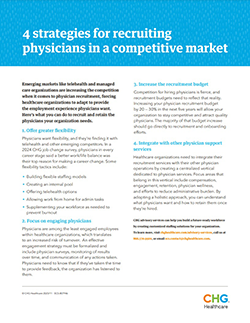
CHG can provide your healthcare facility with the doctors, nurses, and allied professionals you need to provide the best care for your community. Contact us at 866.570.9920 or email ecs.contact@chghealthcare.com.